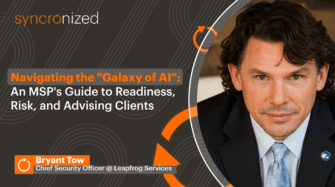Table of contents
- What is IT alerting software and how does it work?
- Why alerting software matters for MSPs and IT teams
- How to pick the best IT alerting software
- Comparison of the best IT alerting software
- Best IT alerting software for MSPs and IT Teams
- IT altering software in real-world scenarios
- Integration and automation capabilities
- IT alerting software pricing models and value for money
- Best IT altering software: Pros and cons
- Tips for selecting the best IT alerting software
- How to choose the best IT alerting software for MSPs and IT teams
- Frequently Asked Questions
For managed service providers (MSPs) and IT operations leads, choosing the best IT alerting software is key to maintaining seamless service delivery, meeting compliance requirements, and exceeding client expectations.
As IT environments become more complex and the threat landscape evolves, MSP decision-makers and IT operations leaders face unique challenges—balancing operational efficiency, regulatory compliance, and client satisfaction, all while avoiding alert fatigue and ensuring smooth integration with existing workflows.
This guide is designed to help you navigate these challenges by comparing the top IT alerting software solutions, highlighting their key features, and providing actionable insights to improve your operational effectiveness.
What is IT alerting software and how does it work?
IT alerting software monitors systems, networks, and applications, automatically notifying IT teams when issues or anomalies arise. The evolution of IT alerting has been significant:
- Early solutions: Provided basic email or SMS notifications for system events.
- Modern platforms: Deliver multi-channel alerts (email, SMS, push, voice), automated escalation, and deep integration with remote monitoring and management (RMM), professional services automation (PSA), and ticketing systems.
- Advanced automation: Today’s solutions can trigger scripts, open tickets, or escalate incidents based on customizable rules, and connect with a wide range of IT management tools for a unified response.
Real-time monitoring allows teams to detect and address issues as soon as they occur, reducing downtime and minimizing business impact. Automated workflows and integration-ready platforms streamline incident response, making IT alerting software a cornerstone of modern IT operations.
Why alerting software matters for MSPs and IT teams
Minimizing downtime is a top priority for MSPs and IT teams. Rapid notification and response prevent minor issues from escalating into major outages, directly impacting client satisfaction and business continuity. Proactive alerts enable teams to resolve problems before clients or end-users even notice.
- Regulatory and compliance implications: Many industries require timely incident detection and reporting to meet standards like HIPAA, GDPR, or SOC 2. Effective alerting software supports compliance by providing audit trails, customizable reporting, and compliance-driven alerting.
- Operational efficiency: Automation and smart routing reduce manual workloads, allowing technicians to focus on higher-value tasks and strategic initiatives.
- Client trust: Reliable alerting builds trust with clients by ensuring transparency and rapid response to incidents.
How to pick the best IT alerting software
When evaluating IT alerting software, prioritize these features:
- Customization and flexibility: Look for platforms that allow you to tailor alert rules, notification channels (email, SMS, push, voice), and escalation paths to fit your team’s workflow.
- Alert fatigue mitigation: Features like alert suppression, deduplication, and intelligent grouping help ensure only actionable issues reach your team, reducing noise and burnout.
- Integration capabilities: Seamless connections with RMM, PSA, ticketing, and communication tools streamline your operations and enable unified incident management.
- Mobile experience: A robust mobile app or responsive web interface empowers technicians to manage alerts and incidents on the go.
- Compliance and reporting tools: Built-in audit trails and customizable reports help you meet regulatory requirements and simplify compliance.
- Onboarding and support: Easy onboarding and high-quality support are essential for rapid adoption and ongoing success.
[Image 2: Screenshot of a customizable IT alerting dashboard with integration options – Alt Text: Customizable IT alerting software dashboard showing integration with RMM, PSA, and ticketing tools]
Comparison of the best IT alerting software
Below is a high-level comparison of leading IT alerting software, focusing on features that matter most to MSPs and IT teams:
| Product | Core features | MSP-specific features | Mobile experience | Integrations | Pricing | Free trial/demo |
| Syncro | RMM, PSA, automation | Multi-tenant, white-label, compliance tools | Full-featured mobile app | Extensive (RMM, PSA, remote access) | Per tech, unlimited endpoints | Yes |
| OpsGenie | Incident management, alerting | Multi-channel alerts, escalation policies | Mobile app available | Integrates with major tools | Per user | Yes |
| PagerDuty | Incident response, on-call management | Custom escalation policies | Mobile app available | Extensive integrations | Per user | Yes |
| AlertManager | Alert management, notification routing | Open-source flexibility | Web interface | Integrates with various tools | Free | N/A |
| xMatters | Incident management, automation | Custom workflows | Mobile app available | Extensive integrations | Per user | Yes |
| Zabbix | Monitoring, alerting | Open-source, customizable | Web interface | Integrates with various tools | Free | N/A |
| Product | Core features | MSP-specific features | Mobile experience | Integrations | Pricing | Free trial/demo |
| Syncro | RMM, PSA, automation | Multi-tenant, white-label, compliance tools | Full-featured mobile app | Extensive (RMM, PSA, remote access) | Per tech, unlimited endpoints | Yes |
| OpsGenie | Incident management, alerting | Multi-channel alerts, escalation policies | Mobile app available | Integrates with major tools | Per user | Yes |
| PagerDuty | Incident response, on-call management | Custom escalation policies | Mobile app available | Extensive integrations | Per user | Yes |
| AlertManager | Alert management, notification routing | Open-source flexibility | Web interface | Integrates with various tools | Free | N/A |
| xMatters | Incident management, automation | Custom workflows | Mobile app available | Extensive integrations | Per user | Yes |
| Zabbix | Monitoring, alerting | Open-source, customizable | Web interface | Integrates with various tools | Free | N/A |
Note: Onboarding experience and support quality are key differentiators, as explored in the next section.
Best IT alerting software for MSPs and IT Teams
Syncro
Syncro delivers a streamlined onboarding experience, with guided setup, extensive documentation, and live support to help MSPs get started quickly. The platform provides 24/7 support, dedicated account managers, and a robust knowledge base. Syncro’s unified RMM and PSA capabilities, automation features, compliance tools, and top-rated mobile app make it a standout choice for MSPs. The platform addresses alert fatigue through smart grouping, offers seamless integrations, flexible pricing, and highly customizable alerts.
OpsGenie
OpsGenie is known for its user-friendly setup, supported by comprehensive tutorials and a responsive support team. The platform offers 24/7 support and a community forum for peer assistance. Key strengths include multi-channel alerts, robust incident management, and customizable escalation policies. Integration capabilities help MSPs and IT teams tailor the platform to their specific needs.
PagerDuty
PagerDuty provides a quick setup process with guided onboarding and extensive documentation. The platform’s 24/7 support ensures users have the resources they need. PagerDuty excels in incident response and on-call management, with strong custom workflow capabilities and mobile accessibility to keep teams connected wherever they are.
AlertManager
AlertManager, an open-source solution, requires technical expertise for setup and configuration. Support is community-driven, which may be a consideration for teams needing more direct assistance. Its main strengths are flexibility and customization, though implementation may require additional resources and technical know-how.
xMatters
xMatters delivers a comprehensive onboarding experience with dedicated support and a wealth of resources. The platform stands out for its automation capabilities, integration options, and support for custom workflows. Mobile access ensures efficient incident management from anywhere.
Zabbix
Zabbix is another open-source option that requires technical setup, but it offers extensive documentation to guide users. Support is available through the community, with paid options for those who need more direct help. Zabbix’s flexibility and monitoring capabilities are strong, though optimal use may require technical expertise.
IT altering software in real-world scenarios
MSPs and IT teams leverage IT alerting software in a variety of ways:
- Proactive endpoint monitoring: Receive instant alerts for device health, patch failures, or security threats, enabling rapid response.
- Compliance-driven alerting and reporting: Essential for industries subject to regulations like HIPAA, GDPR, or SOC 2. Automated notifications and audit-ready reports simplify compliance.
- Automated ticket creation and status updates: Keep clients and end-users informed, improving communication and transparency.
- Mobile response capabilities: Empower technicians to resolve issues from anywhere, ensuring high service levels even when teams are on the move.
Integration and automation capabilities
Ease of integration is a hallmark of leading IT alerting platforms. Many offer plug-and-play connectors and open APIs, making it simple to build custom workflows and connect with third-party tools. For example, Syncro’s open API allows MSPs to automate ticket creation, trigger scripts, or sync alerts with other IT management platforms. Automation triggers can execute scripts, create tickets, or escalate incidents based on alert type or severity, streamlining incident response and reducing manual intervention.
IT alerting software pricing models and value for money
IT alerting software pricing models are designed to accommodate a range of business needs:
- Flexible pricing: Options include per-endpoint, per-user, or flat-rate models, allowing MSPs to choose the structure that best fits their operations.
- Free trials and demos: Most leading solutions offer free trials or live demos, providing a risk-free way to evaluate features and fit.
- Contract flexibility: Month-to-month and annual agreements are available to suit different business models and growth stages.
Best IT altering software: Pros and cons
| Product | Alert fatigue | Integration | Cost | Customization | Mobile | Onboarding |
| Syncro | ✓ | ✓ | ✓ | ✓ | ✓ | ✓ |
| OpsGenie | ✓ | ✓ | ✓ | ✓ | ✓ | ✓ |
| PagerDuty | ✓ | ✓ | ✓ | ✓ | ✓ | ✓ |
| AlertManager | ✓ | ✓ | ✓ | ✓ | ✓ | ✗ |
| xMatters | ✓ | ✓ | ✓ | ✓ | ✓ | ✓ |
| Zabbix | ✓ | ✓ | ✓ | ✓ | ✓ | ✗ |
This summary highlights how each platform addresses common pain points, including alert fatigue, integration, cost, customization, mobile experience, and onboarding.
Tips for selecting the best IT alerting software
- Pilot or trial solutions: Take advantage of free trials and pilot programs to test alerting workflows, integrations, and support responsiveness before full deployment.
- Start with best practices: Use vendor-recommended alert rules, then customize them to fit your team’s needs and minimize noise.
- Train your team: Ensure everyone understands escalation paths and how to use mobile tools for incident response.
- Evaluate support quality: Consider onboarding resources and ongoing support, as these can significantly impact your team’s success.
How to choose the best IT alerting software for MSPs and IT teams
Selecting the best IT alerting software is essential for MSPs and IT teams aiming to deliver proactive, compliant, and efficient service. Syncro stands out with its unified platform, automation, and MSP-focused features—empowering you to stay ahead of issues and exceed client expectations.
Ready to see how Syncro can transform your IT alerting?
Request a demo or start your free trial today.
Frequently Asked Questions
Leading platforms offer audit trails, customizable reporting, and compliance-driven alerting to help MSPs meet industry regulations.
Yes. Most modern IT alerting platforms are designed for scalability, supporting multi-tenant environments and flexible licensing.
Look for features like intelligent grouping, deduplication, and customizable thresholds to ensure only actionable alerts reach your team.
Top solutions integrate with RMM, PSA, ticketing, communication, and security tools—often via open APIs.
Yes. Syncro and other leading platforms offer robust mobile apps for real-time management and response.dly evolving market.
Share














